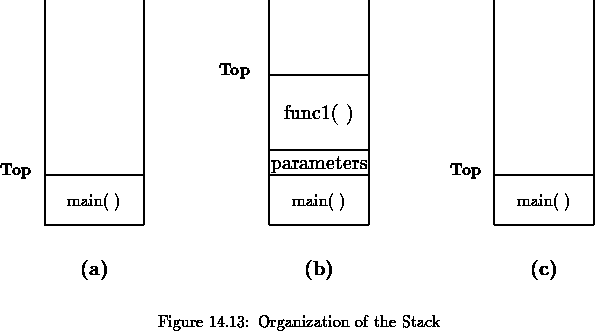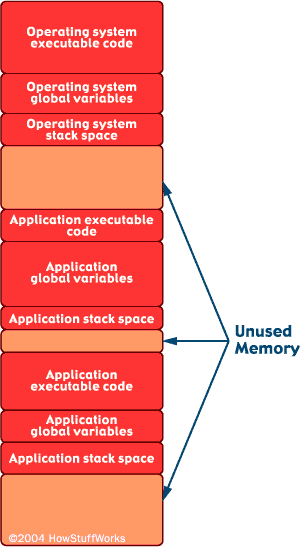εè·δΜΞδΜéδΗ≠φâë÷àΑεΛßιÉ®εàÜφ•΅δΜΕφ†ΦεΦèγö³γ¦ΗεÖ≥δΩΓφ¹·ψIJδΨ΄εΠ²BMPεQ¨ObjΫ{âγ≠âψÄ?br />
http://www.csit.fsu.edu/~burkardt/data/obj/obj.html
δΜ΄γΜçOBJφ•΅δögφ†ΦεΦèεQ¨εÖ≥ιî°φ‰·εΫ™δΗ≠φèêδΨ¦δΚÜη·ΜεÜô壨ηΫ§φçΔOBJφ•΅δögγö³εΖΞεÖΖεΨèη°°ψÄ?br />
Stack vs Heap Allocation
How the memory of the computer is organized for a running program? When a program is loaded into memory, it is organized into three areas of memory, called segments: the text segment, stack segment, and heap segment. The text segment (sometimes also called the code segment) is where the compiled code of the program itself resides. This is the machine language representation of the program steps to be carried out, including all functions making up the program, both user defined and system.
The remaining two areas of system memory is where storage may be allocated by the compiler for data storage. The stack is where memory is allocated for automatic variables within functions. A stack is a Last In First Out (LIFO) storage device where new storage is allocated and deallocated at only one ``end'', called the Top of the stack. This can be seen in Figure 14.13. 
 
When a program begins executing in the function main(), space is allocated on the stack for all variables declared within main(), as seen in Figure 14.13(a). If main() calls a function, func1(), additional storage is allocated for the variables in func1() at the top of the stack as shown in Figure 14.13(b). Notice that the parameters passed by main() to func1() are also stored on the stack. If func1() were to call any additional functions, storage would be allocated at the new Top of stack as seen in the figure. When func1() returns, storage for its local variables is deallocated, and the Top of the stack returns to to position shown in Figure 14.13(c). If main() were to call another function, storage would be allocated for that function at the Top shown in the figure. As can be seen, the memory allocated in the stack area is used and reused during program execution. It should be clear that memory allocated in this area will contain garbage values left over from previous usage.
The heap segment provides more stable storage of data for a program; memory allocated in the heap remains in existence for the duration of a program. Therefore, global variables (storage class external), and static variables are allocated on the heap. The memory allocated in the heap area, if initialized to zero at program start, remains zero until the program makes use of it. Thus, the heap area need not contain garbage.
û°èγΜ™εQ?br />Stack: automatic variables within functions
Heap: global variables (storage class external), and static variables
============================
In java φÉÖεÜΒεΠ²δΗ΄
(1)
 The stack is the program memory area, so all your primitive type variables and the memory adress of your objects are written on the stack. It is a fast access valuable memory area.
The heap is where the VM keeps the objects, and it is a huge amount of memory. When you create an object, the VM puts the object in the HEAP and puts the adress of the object created on the STACK.
(2)
 There are two kinds of memory used in Java. These are called stack memory and heap memory. Stack memory stores primitive types and the addresses of objects. The object values are stored in heap memory. An object reference on the stack is only an address that refers to the place in heap memory where that object is kept.
¬†It is useful to know that these two different kinds of memory exist in Java. Stack memory is the program's memory, and heap memory resides outside of the program.‰qôεΞΫεÉèφ€âγ²ΙηΖüCγö³δΗçεê¨οΦàγ¦ΗεèçεQâψÄ?br />εΦïεÖΞδΗÄγ²ΙεûÉε€ë÷¦ûφîΕφ€ΚεàΕγö³γüΞη·Ü
 When you need a new object, Java allocates the required memory. When you are done with an object, the memory is reclaimed for you automatically via Java's garbage collection facility.
 Garbage collection runs as a thread in the background, looking for objects that no longer have a usable reference. When it finds them, it destroys them and reclaims the memory.
 The implementation of garbage collection varies between Java Virtual Machines. They generally follow the same process, however. First, the garbage collector gets a snapshot of all running threads and all loaded classes. Then, all objects that are referred to by this thread set are marked as current. The process stops when all objects that it is possible to reach have been marked and the rest have been discarded.
 In order to help the Virtual Machine, it is a good idea to remove your references to unneeded objects. This is often done by simply setting your reference to null:
 Test t = new Test();
 t.someAction();
 // all done
 t = null;
û°èγΜ™εQ?br />Stack: Primitive data types(primitive types), the addresses of objects(=references).
Heap:  objects.
===============================================
δΜéγ≥ΜΨlüγö³ηߣεΚΠγ€?stackεQàφ†àεQâ壨heap(ε†ÜοΦâ
Dynamic Data Structures: The Heap
A typical personal computer or workstation today has somewhere between 16 and 64 megabytes of RAM installed. Using a technique called virtual memory, the system can swap pieces of memory on and off the machine's hard disk to create an illusion for the CPU that it has much more memory, for example 200 to 500 megabytes. While this illusion is complete as far as the CPU is concerned, it can sometimes slow things down tremendously from the user's perspective. Despite this drawback, virtual memory is an extremely useful technique for "increasing" the amount of RAM in a machine in an inexpensive way. Let's assume for the sake of this discussion that a typical computer has a total memory space of, for example, 50 megabytes (regardless of whether that memory is implemented in real RAM or in virtual memory).
The operating system on the machine is in charge of the 50-megabyte memory space. The operating system uses the space in several different ways, as shown here:
 
The operating system and several applications, along with their global variables and stack spaces, all consume portions of memory. When a program completes execution, it releases its memory for reuse by other programs. Note that part of the memory space remains unused at any given time.
This is, of course, an idealization, but the basic principles are correct. As you can see, memory holds the executable code for the different applications currently running on the machine, along with the executable code for the operating system itself. Each application has certain global variables associated with it. These variables also consume memory. Finally, each application uses an area of memory called the stack, which holds all local variables and parameters used by any function. The stack also remembers the order in which functions are called so that function returns occur correctly. Each time a function is called, its local variables and parameters are "pushed onto" the stack. When the function returns, these locals and parameters are "popped." Because of this, the size of a program's stack fluctuates constantly as the program is running, but it has some maximum size.
As a program finishes execution, the operating system unloads it, its globals and its stack space from memory. A new program can make use of that space at a later time. In this way, the memory in a computer system is constantly "recycled" and reused by programs as they execute and complete.
In general, perhaps 50 percent of the computer's total memory space might be unused at any given moment. The operating system owns and manages the unused memory, and it is collectively known as the heap. The heap is extremely important because it is available for use by applications during execution using the C functions malloc (memory allocate) and free. The heap allows programs to allocate memory exactly when they need it during the execution of a program, rather than pre-allocating it with a specifically-sized array declaration.
ε€®εΑùη·ïεΨèγΪ΄η΅ΣεΖόqö³εè·ι΅çγî®packageγö³φ½ΕεÄôοΦ¨ε·Ιpackage壨importη·≠εèΞε¹öδΚÜδΚ¦η·ïιΣ¨οΦ¨η°ΑεΫïΨl™φû€εΠ²δΗ΄ψÄ?/p>
δΫΩγî®η·¥φ‰éεQ?br />(1)ε·ΙδΚésrc\com\cjren\util\ClassA.java‰qôδΗΣφèêδΨ¦ΨlôεÖΕδΜ•γ±ΜδΫΩγî®γö³class.
package com.cjren.util;
public class ClassA {
  ...
}
Ψ~•η·ëφ½?
javac -d . ClassA.java¬† // -d . ηΓ®γΛΚδΚÜδΜΞεΫ™εâçγ¦°εΫïδΗΚpackageη·≠εèΞγîüφàêγö³γ¦Ηε·“é†Ιγ¦°εΫïψÄ?br />Ψl™φû€φ‰·ε€®ClassA.javaφâÄε€®γö³γ¦°εΫïδΗ΄γîüφàêδΚÜcom.cjren.utilε¨Öο֨顨ιùΔεêΪClassA.classεQ¨ηΩôδΗΣε¨Öεè·δΜΞεΛçεàΕεâΣη³™εàΑεÖΕδΜ•γö³ε€Αφ•ΙδΨ¦εÖΕδΜ•γ±ΜδΫΩγî®ψÄ?br />Notes:
εΩÖιΓΜδΫΩγî®"-d ."εQ¨εêΠεàôClassA.classρqΕδΗçδΦöφîΨε€®com.cjren.utilε¨Ö顨ιùΔοΦ¨ηĨφ‰·γîüφàê倮壨ClassA.javaγ¦Ηεê¨γö³γ¦°εΫïδΗ΄ψÄ?/p>
(2)ε·ΙδΚéηΠ¹δ΄…γî®ClassAγö³ClassB.java.
import com.cjren.util.ClassA;
public class ClassB {
  ... // use ClassA here
}
To compile: javac ClassB.java
To run:¬†¬†¬†¬† ε¹΅η°Ψcomε¨ÖφîΨ倮壨ClassB.javaγö³εΫ™εâçγ¦°εΫ?br />¬†¬†¬†¬†¬†¬†¬†¬†¬†¬†¬† java ClassB¬†¬†¬†¬†¬†¬†¬†
            // or java -cp . ClassB // here use the "-cp ." as the current directory to find the package com.
¬†¬†¬†¬†¬†¬†¬†¬†¬†¬†¬† ε¹΅η°Ψcomε¨ÖφîΨε€®D:\Program Files\Java\mypackagesδΗ?br />¬†¬†¬†¬†¬†¬†¬†¬†¬†¬†¬† java -cp D:\Program Files\Java\mypackages ClassB
Notes:
ιîôη··δΗÄεQ?br />package com.cjren.util;
public class ClassA {
  ...
}
Ψ~•η·ëεêé㦥φéΞφääcom.cjren.utilε¨Ö顨ιùΔγö³ClassA.classφ•΅δögφ΄·²¥ùεàΑ壨ClassB.javaγ¦Ηεê¨γö³γ¦°εΫïδǴ㦥φéΞδΫΩγî®εQ?br />public class ClassB {
  ... // use ClassA here
}
To compile: javac ClassB.java
ιîôη··δΩΓφ¹·φ‰?br />"ClassB.java:φüêδΗÄηΓ? φ½†φ≥ïη°âK½° ClassA
¬†ιîôη··γö³γ±Μφ•΅δögεQ?.\ClassA.class
¬†ΨcάL•΅δΜΕε¨ÖεêΪιîôη··γö³ΨcΜοΦö com.cjren.util.ClassA
¬†η·Ζεà†ιôΛη·Ξφ•΅δögφà•γΓ°δΩùη·Ξφ•΅δögδΫçδΚéφ≠ΘγΓ°γö³γ±ΜηΖ·εΨ³ε≠êγ¦°εΫïδΗ≠ψÄ?
φÉ≥δΗÄφÉ≥δΊ™δΜÄδΙàε΅ΚιîôδΩΓφ¹·φ‰·η·Ώ_ΦöβÄ€ιîôη··γö³ΨcάL•΅δΜ”ûΦö .\ClassA.classεQ?ΨcάL•΅δΜΕε¨ÖεêΪιîôη··γö³ΨcΜοΦö com.cjren.util.ClassAβÄùεëΔεQü妆δΗ?ιîôη··γö³γ±Μφ•΅δögεQ?.\ClassA.class"εΫ™δΗ≠ε¨ÖεêΪδΚ?ιîôη··γö³γ±ΜεQ?com.cjren.util.ClassA"‰qôδΗΣδΩΓφ¹·εQ¨ηĨηΩôδΗ?com.cjren.util.ClassA"φ‰·ε€®ClassA.javaδΗ≠γö³"package com.cjren.util;"η·≠εèΞφâÄιĆφàêγö³ψÄ?br />φ≠ΘγΓ°γö³ε¹öφ≥ïφ‰·φääClassA.classφâÄε€®γö³ε¨Öφï¥δΗΣεΛçεàΕγ≤‰η¥¥εàΑClassB.javaφâÄε€®γö³γ¦°εΫïδΗ΄οΦ¨φà•ηÄÖε€®ClassB.javaφâÄε€®γö³γ¦°εΫïδΗ΄δùhδΗΚφâ΄εä®γö³εΜΚγΪ΄com\cjren\util\γ¦°εΫïεQ¨γ³Εεêé㦥φéΞφääClassA.classφ•΅δögεΛçεàΕΨ_‰η³™εàΑφ≠ΛψIJηΩôφö½γΛΚδΚÜδΜΘγ†¹γîüφàêγö³ε¨Ö壨φâ΄εä®εΜΚγΪ΄γö³γ¦°εΫïεè·ηÉΫφ‰·δΗÄφ†½ςÄ?br />εè·ηß¹,εΫ™ClassA.javaγö³φΚêδΜΘγ†¹δΗ≠εêΪ"package com.cjren.util;"η·≠εèΞεQ¨εàôγîüφàêcom.cjren.utilε¨Ö顨ιùΔγö³ClassA.classφ•΅δög顨ιùΔεΚîη·Ξû°ΉÉΙüε¨ÖεêΪδΚÜη΅ΣεΖόpΩôδΗΣclassφ•΅δögφâÄε±ûγö³ε¨ÖδΩΓφ¹·οΦ¨φâÄδΜΞηΩôδΗΣClassA.classεèΣηÉΫφîë÷€®‰qôδΗΣδΜΘγ†¹δΗ≠εΖ≤Ψlèφ¨΅ε°öγö³γâΙε°öε¨Öγö³ηΖ·εΨ³δΗ΄δ΄…γî®οΦ¨ηĨδΗçηÉΫφää‰qôδΗΣClassA.class㴧γΪ΄ε΅ΚφùΞδΫΩγî®εQ¨ε¦†δΗχôΩôφ†οLö³η·ùεΑÜClassA.classφ•΅δögε±ûφÄßδΗ≠γö³γö³ε¨ÖδΩΓφ¹·δΗçγ¦Ηγ§ΠψIJεΫ™γ³ΕεΫ™‰qôδΗΣClassA.javaφ≤Γφ€âφ‰ë÷Φèε€ΑεàΕε°öpackageη·≠εèΞδΩΓφ¹·φ½ΕεÄôοΦ¨φàëφÄÄγ•ëοΦàδΙüηßâεΨ½εΚîη·ΞοΦâφ‰·ιΜ‰η°Λε€®ClassA.classφ•΅δögεΫ™δΗ≠ε¨ÖεêΪδΚÜε¨Öγö³δΩΓφ¹·εΑ±φ‰?."εQ¨εè·δΜΞγêÜηßΘδΊ™ιΜ‰η°Λγö³εä†εÖΞδΚÜ"package .;"η·≠εèΞψÄ?/p>
ιîôη··δΚ¨οΦö
public class ClassA {
  ...
}
Ψ~•η·ëεêéηΩôδΗΣClassA.classφ•΅δögδΗ≠εêΪφ€âγö³ε¨Öγö³δΩΓφ¹·φ‰?."εΫ™εâçγ¦°εΫïû°±ε¨ÖεQ?br />φääηΩôδΗΣClassA.classφ•΅δögεQ¨γßΜεàνCΜΞClassB.javaφâÄε€®γö³γ¦°εΫïδΗΚεΫ™εâçγàΕγ¦°εΫïγö³δùhδΗΚφâ΄εä®εΨèγΪ΄γö³com\cjren\utilγ¦°εΫïδΗ΄ψÄ?br />import com.cjren.util.ClassA;
public class ClassB {
  ... // use ClassA here
}
To compile: javac ClassB.java
ιîôη··δΩΓφ¹·φ‰?br />"ClassB.java:φüêδΗÄηΓ? φ½†φ≥ïη°âK½° com.cjren.swing.ClassA
¬†ιîôη··γö³γ±Μφ•΅δögεQ?.\com\cjren\util\ClassA.class
¬†ΨcάL•΅δΜΕε¨ÖεêΪιîôη··γö³ΨcΜοΦö ClassA
¬†η·Ζεà†ιôΛη·Ξφ•΅δögφà•γΓ°δΩùη·Ξφ•΅δögδΫçδΚéφ≠ΘγΓ°γö³γ±ΜηΖ·εΨ³ε≠êγ¦°εΫïδΗ≠ψÄ?
φÉ≥δΗÄφÉ≥δΊ™δΜÄδΙàε΅ΚιîôδΩΓφ¹·φ‰·η·Ώ_ΦöβÄ€ιîôη··γö³ΨcάL•΅δΜ”ûΦö .\com\cjren\util\ClassA.classεQ¨γ±Μφ•΅δögε¨ÖεêΪιîôη··γö³γ±ΜεQ?ClassAβÄùεëΔεQü妆δΗόZΫ†‰qôδΗΣcom.cjren.utilε¨ÖδΗ≠γö³ClassA.classφ•΅δögφ€§φùΞφâÄιΜ‰η°Λγö³ε¨ÖδΩΓφ¹·φ‰?."εQ¨ε€®ClassA.javaδΗ≠εΤàφ≤Γφ€âδΫΩγî®"package"η·≠εèΞφ¨΅ε°öClassAεΚîη·Ξε±ûδΚéε¨Öcom\cjren\util‰qôδΗΣδΩΓφ¹·ψÄ?/p>
û°èγΜ™εQ?br />ε€®εΑùη·ïηΩ΅ΫE΄εΫ™δΗ≠εèëγééΆΦ¨
public class ClassA {
  ...
}
ε£?br />package com.cjren.util;
public class ClassA {
  ...
}
‰qôδΗΛδΗΣεèΣεΖ°δΚÜδΗÄδΗΣpackageη·≠εèΞγö³classφ•΅δögεΛßεΑèφ€âεç¹ε΅†εàΑ塆εç¹kδΗäγö³ε¨ΚεàΪεQ¨ηΩôεè·ηÉΫ‰q¦δΗÄφ≠Ξη·¹φ‰éδΚÜ.javaφ•΅δögδΗ≠γö³packageη·≠εèΞδΦöε€®.classφ•΅δögδΗ≠εä†εÖΞγ¦ΗεΚîγö³ε¨ÖδΩΓφ¹·οΦ¨‰qôδΗΣε¨ÖδΩΓφ¹·εÜ≥ε°öδΚ܉qôδΗΣclassηΔΪδ΄…γî®φ½ΕεÄôγö³φ•ΙεΦèεQàφ‰·εêΠι€ÄηΠ¹importγâΙε°öγö³ε¨ÖεQâψÄ?br />‰q‰φ€âδΗÄγ²ΙηΠ¹φ≥®φ³èγö³φ‰·εQ?br />package com.cjren.util;
public class ClassA {
  ...
}
δΙ΄εêéφ½†η°Κφ‰·δ΄…γî?javac ClassA.java φà•ηÄ?javac -d . ClassA.javaΨ~•η·ëιÉΫδΗçδΦöεΣ³ε™çClassA.classφ•΅δögεΫ™δΗ≠φâÄεêΪφ€âγö³ε¨ÖδΩΓφ¹·εQ¨ηΩôδΗΛγßçΨ~•η·ëφ•ΙεΦèφâÄιĆφàêγö³ε¨ΚεàΪε€®δΗäιùΔγö³δ΄…γî®η·¥φ‰éδΗ≠εΖ≤γΜèη·¥ηΩ΅δΚÜψÄ?/p>
 
û°ùη·ïδΜΞδΗÄδΗΣδΨ΄ε≠êφùΞη·¥φ‰éφê≠εΨèδΗÄδΗ?/span> project φ½ΕεÄôγö³γ¦°εΫïφû³εΨèφÉÖεÜΒψÄ?/span>
φÉÖεÜΒδΗÄ
δΗ΄ιùΔδΜΞδΗÄδΗΣε€Α妳ΓΦ•ηΨëεô®γö³δΨ΄ε≠êδΊ™δΨ?/font>
γàΕγ¦°εΫïφ‰·
βÄùproject mapeditorβÄ?
.\Image εQ?/span> ΫE΄εΚèδΫΩγî®εàΑγö³ε¦³Γâ΅ψÄ?/span>
.\Maps εQ?/span> ΫE΄εΚè‰qêηΓ¨φ½Εγî®φàΖδΩùε≠‰γö³η΅Σε°öδΙâε€Αε¦ΨψÄ?/span>
.\com εQ?/span> δΗ»ù®΄εΚ?/span> MapEditor.java û°ÜδΦöφ‰·γî®εàΑγö³ package γö³φΚêφ•΅δögψÄ?/span>
.\com\cjren\swing\MyFilter.java
MapEditor.java εQ?/span> δΗ»ù®΄εΚèφΚêφ•΅δögεQ¨δΜΘγ†¹δΗ≠φ≤Γφ€â βÄùpackageβÄ?/span> η·≠εèΞψÄ?/span>
runMapEditor.bat εQ?/span> ε°¨φàêΨ~•η·ë壨ηΩêηΓ¨φâÄι€Äγö³φâÄφ€âεΖΞδΫ€ψÄ?/span>
δΗ΄ιùΔδΗΜηΠ¹γ€΄γ€΄ runMapEditor.bat γö³εÜÖε°ΙοΦö
@echo off
rem output the date and time
date /T
time /T
echo welcome to my map editor :-)
rem make the directory for class files
mkdir .\build\classes
rem compile the source files
javac -d .\build\classes MapEditor.java
rem run the application,
rem but you must avoid this: java.\build\classes\MapEditor,
rem which will be an error
java -cp .\build\classes MapEditor
rem clean everything in the build folder
rmdir .\build /S /Q
pause
δΜéδΗäιùΔγö³εÖΖδΫ™δΜΘγ†¹δΗ≠εè·δΜΞ〴ε΅Κε€®Ψ~•η·ë壨ηΩêηΓ¨γö³φ½ΕεÄôοΦ¨φâÄφ€âγö³ class φ•΅δögιÉΫε¦ûηΔΪφîΨε€?/span> .\build\classes ‰qôδΗΣφ•΅δögεΛΙδΗ≠εQ¨ηΩôδΗΣφ•΅δΜΕεΛΙφ‰·εä®φĹγîüφàêεΤàδΗîφ€ÄεêéδΦöηΔΪφΗÖφΞöφéâγö³ψÄ?/span>
‰qô顨φ€âδΗâδΗΣεÄΦεΨ½φ≥®φ³èγö³ε€Αφ•èVÄ?/span>
δΗÄεQ¨ιÄöηΩ΅ βÄ?javac -d .\build\classes MapEditor.javaβÄ?/span> εQ¨δΗçεçïεèΣφ‰?/span> MapEditor.java φâÄε°öδΙâγö?/span> class ιÉΫηΔΪφîΨδΚé .\build\classes δΗ≠οΦ¨γîöη΅≥‰q?/span> .\com δΗ?/span> MyFilter.java φâÄε·ΙεΚîγö?/span> class δΙüιÉΫε€?/span> .\build\classes\com\cjren\swing δΗ≠οΦ¨ηÄ?/span> com ε¨Öε€® .\bulid\classes δΗ΄φ‰·η΅Σεä®ηΔΪε΅ÜΦ΄°γîüφàêγö³ψIJδΙüû°±φ‰·η·¥φâÄφ€âγö³ .class φ•΅δögιÉΫηΔΪφîë÷€® .\bulid\classes φ•΅δögεΛΙδΗ≠δΚÜψÄ?/span>
δΚ¨οΦ¨εΫ™δ΄…γî?/span> βÄùjava -cp .\build\classes MapEditorβÄ?/span> φùΞηΩêηΓ¨γ®΄εΚèγö³φ½ΕεÄôοΦ¨ρqΕφ≤Γφ€â妆δΗ?/span> Image φ•΅δögεΛΙδΗçε€?/span> .\build\classes ηĨε΅ΚιîôψIJηΩôη·¥φ‰éδΚ?/span> .java φ•΅δögδΗ≠γö³δΜΘγ†¹εΖ≤γΜèεܦ_°öδΚÜε°ÉφâÄδΫΩγî®εàΑγö³ Image φ•΅δögεΛΙγö³δΫçγΫ°εQ¨ηΩôδΗΣδΫçΨ|°φ‰·γ¦Ηε·ΙδΚ?/span> .java φ•΅δögφâÄε€®γö³δΫçγΫ°φùΞη·¥γö³οΦ¨ηĨδΗçφ‰?/span> .class ψÄ?/span>
δΗâοΦ¨φàëεΑùη·ïδΚÜε€?/span> d 㦉δΗ΄φ•ΑεΨèδΚÜδΗÄδΗ?/span> a γ¦°εΫïεQ¨γ³Εεêéφää
javac -d .\build\classes MapEditor.java
java -cp .\build\classes MapEditor
φçΔφàê
javac -d d:\a MapEditor.java
java -cp d:\a MapEditor
δΙ΄εêéεQ¨εÖΕδΜ?/span> βÄùproject mapeditorβÄ?/span> δΗ΄γö³φâÄφ€âδΗ€ηΞâKÉΫφ≤Γφ€âφîΙεè‰εQ¨γ®΄εΚèδΨùγ³ΕφàêεäüφâßηΓ¨ψIJηΩôû°όpΩ¦δΗÄφ≠Ξη·¹φ‰éδΚÜ .java φ•΅δögδΗ≠γö³δΜΘγ†¹εܦ_°öδΚÜφâÄφ€âεÖΕδΜ•γ¦°εΫïφà•φ•΅δögεÖÉ㥆γö³γ¦Ηε·ΙδΫçΨ|°οΦ¨‰qôδΗΣδΫçγΫ°δΜ?/span> .java φ•΅δögφâÄε€®γö³γ¦°εΫïδΗΚφ†΅ε΅ÜψIJηĨδΗé .class φ•΅δögγö³ηΒ\εΨ³φ½†εÖüκIJδΫÜφ‰·οΦöεàΪφΊ€φΖÜδΚÜ A.class ε°ÉφâÄδΫΩγî®εàΑγö³ε¨Öγö³ .class γö³ηΒ\εΨ³φ‰·δΜ?/span> A.class φ•΅δögγö³ηΒ\εΨ³δΊ™φ†΅ε΅Üγö³οΦ¹εQ¹οΦ¹‰qôεΑ±δΗéδΗäιù?/span> MapEditor.class δΙü壨εQàεΩÖôε’d£¨εQ?/span> com ε¨Öεê¨εΛ³δΚé bulid\classes γ¦°εΫïδΗ΄φ≤Γφ€âγü¦γ¦ΨψÄ?/span>
φÉÖεÜΒδΚ?/span>
γ¦°γö³φ‰·φääδΗäιùΔφÉÖεÜΒδΗÄδΗ≠φâÄφ€âγö³φ•΅δög壨φ•΅δΜΕεΛΙιÉΫε¨ÖεêΪε€® src ‰qôδΗΣφ•΅δögεΛΙδΗ≠εQ¨ηÄ?/span> src φ€§ημnû°±φ‰·γàΕγ¦°εΫ?/span> project mapeditor2 δΗ΄γö³δΗÄδΗΣφ•΅δΜΕεΛΙψIJηĨδΗîφàëεΗ¨φ€¦γΦ•η·ëφ½ΕεÄôγîüφàêγö³ build φ•΅δögεΛΙ壨 src φ•΅δögεΛΙγö³εÖ≥γ≥Μφ‰·οΦö
\project mapeditor2\src
\project mapeditor2\build
src
φ•΅δögεΛΙγö³εÜÖε°ΙεΠ²δΗ΄εQ?/span>
φ≥®φ³èφâΙεΛ³γêÜφ•΅δΜ?/span>
runMapEditor.bat
ε€?/span>
src
φ•΅δögεΛΙδΗ΄εQ¨ηĨδΗîε€®φ≠ΛφÉÖεÜΒδΗ΄οΦ¨
runMapEditor.bat
γö³εÜÖε°ΙεΑÜφ€âφâÄεè‰ε¨•εQ?/span>
@echo off
rem output the date and time
date /T
time /T
echo welcome to my map editor :-)
rem make the directory for class files
mkdir ..\build\classes
rem compile the source files
javac -d ..\build\classes MapEditor.java
rem run the application,
rem but you must avoid this: java.\build\classes\MapEditor,
rem which will be an error
java -cp ..\build\classes MapEditor
rem clean everything in the build folder
rmdir ..\build /S /Q
pause
φÉÖεÜΒδΗÄ壨φÉÖεÜΒδΚ¨γö³εΖ°εàΪδΗçεΛßοΦ¨εèΣφ‰·φΚêδΜΘγ†¹φ•΅δΜΕεΛöδΗÄε±²γö³φ•΅δögεΛΙγö³ε¨ÖηΘΙψIJηĨδΗîφ€ÄεΛßγö³εÖ±εê¨γ²“鉷 runMapEditor.bat 壨φΚêδΜΘγ†¹φ•΅δögε€®εê¨δΗÄδΗΣφ•΅δΜΕεΛΙδΗ΄ψÄ?/span>
φÉÖεÜΒδΗ?/span>
û°ùη·ïε€®φÉÖεÜΒδΚ¨γö³εüΚΦ΄ÄδΗäφää runMapEditor.bat φèêεàΑε£?/span> src δΜΞεèä build γ¦Ηεê¨γö³γàΕγ¦°εΫïδΗ΄ψÄ²ε¹΅η°³ΓàΕγ¦°εΫïφ‰?/span> project mapeditor3 εQ¨εàôεQ?/span>
γéΑε€®
runMapEditor.bat
γö³εÜÖε°“é‰·εQ?/span>
@echo off
rem output the date and time
date /T
time /T
echo welcome to my map editor :-)
rem make the directory for class files
mkdir .\build\classes
rem go into the src directory
cd src
rem compile the source files
javac -d ..\build\classes MapEditor.java
rem run the application,
rem but you must avoid this: java.\build\classes\MapEditor,
rem which will be an error
java -cp ..\build\classes MapEditor
rem clean everything in the build folder
rmdir ..\build /S /Q
pause
ε€®εΑùη·ïεΖΞΫE΄εΫ™δΗ≠οΦ¨εèëγéΑδΜΞδΗ΄γö³ε¹öφ≥ïεΑÜφâΨδΗçεà?/span> Image φ•΅δögεΛΙοΦö
cd src
javac -d ..\build\classes MapEditor.java
cd ..
java -cp .\build\classes MapEditor
‰qôγßçδΩ°φîΙφâÄιĆφàêγö³ε¨ΚεàΪφ‰·‰qêηΓ¨ βÄùjavaβÄ?/span> εëΫδΉoγö³δΫçΨ|°δΗçεê¨δΚÜψIJεè·δΜΞ㨀φÉœx‰·ι€ÄηΠ¹ε€® src φ•΅δögεΛΙεÜÖ‰qêηΓ¨ java εëΫδΉoεQ¨ηÄ?/span> src φ•΅δögεΛΙδΗ≠εêΪφ€âφâÄφ€âγ®΄εΚèφâÄι€Äγö³δΜΘγ†¹ε£¨ image 㥆φùêψÄ?/span>
δΗ΄ιùΔφèêδΨ¦δΗÄδΗΣγ®çεΨ°δΗçεê¨γö³φâΙεΛ³γêÜφ•΅δΜ”ûΦ¨ runMapEditor2.bat εQ¨ε°ÉδΙüεê¨φ†ΖεΛ³δΚ?/span> project mapeditor3 ‰qôδΗΣγàΕγ¦°εΫïδΗ΄εQ?/span>
runMapEditor2.bat
γö³εÜÖε°ΙεΠ²δΗ΄οΦö
@echo off
mkdir d:\a
cd src
javac -d d:\a MapEditor.java
java -cp d:\a MapEditor
rmdir d:\a /S /Q
pause
‰qôδΗΣδΩ°φîΙ‰q΅γö³δΨ΄ε≠êφä?/span> class φ•΅δögιÉΫγßΜεàΑηΨɉq€γö³ε€Αφ•Ι (d:\a) εQ¨δΫÜφ‰·ηΩ‰εè·δΜΞφàêεäü‰qêηΓ¨ψIJεΑèΨl™δΗÄδΗ΄ε°ÉηÉΫφàêεäüηΩêηΓ¨γö³γâΙγ²ΙεQ?/span>
δΗÄεQ?/span> src φ•΅δögεΛΙδΗ≠εΖ≤γΜèε¨ÖεêΪδΚÜφâÄφ€âγö³εÖÉ㥆εQ¨ε¨Öφ΄§φâÄι€Äγö³εΛ•ιÉ?/span> package δΜΘγ†¹εQ¨ε¨Öφ΄?/span> image φ•΅δögεΛèVIJηΩôδΚ¦εÖÉ㥆ιÉΫεΩÖιΓΜδΫΩεΨ½δΗ»ù®΄εΚ?/span> .java ηÉΫφàêεäüγö³Ψ~•η·ëψÄ?/span>
δΚ¨οΦ¨‰qêηΓ¨ βÄùjavaβÄ?/span> εëΫδΉoιÉΫε€® src ‰qôδΗΣγ¦°εΫïδΗ΄ψIJδΙüû°±φ‰·η·¥ιÉΫ倮壨δΜΘγ†¹εΛ³ε€®γ¦Ηεê¨γö³φ•΅δΜΕηΒ\εΨ³δΗ΄εQ¨ηĨδΗçφ‰·εÖΕδΜ•δ™QδΫïηΒ\εΨ³ψÄ?/span>
φÉÖεÜΒδΗÄιÉΫδΗâγö³εΑèΨl?/span>
εüΚφ€§φΜΓηÉωδΚÜε€® windows Ψp»ùΜüδΗ΄εΦÄεèëεΑèôεΙγ¦°γö³ι€Äφ±²οΦ¨φàëε€®‰qôδΗâδΗΣεΑùη·ïγö³δΨ΄ε≠êδΗ≠δΗΜΫE΄εΚè MapEditor.java ιÉΫφ≤Γφ€âεêΪφ€?/span> βÄùpackage mainβÄ?/span> ‰qôγ±Μγö³φâ™ε¨Öη·≠εèΞψÄ?/span>